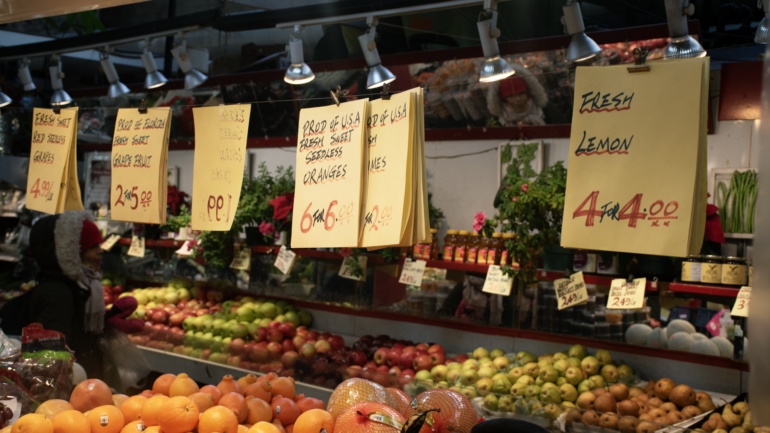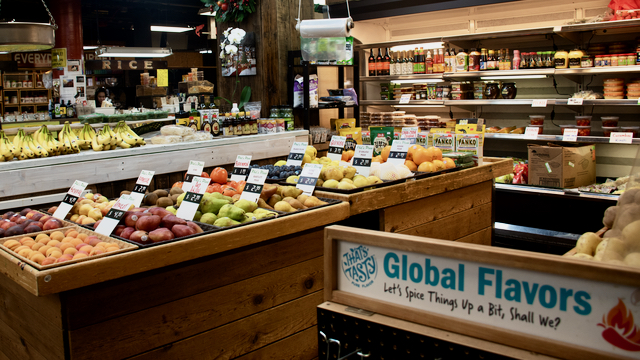Yuming Kuo, a first-semester Architecture Technology student at Humber College, thought $300 for a month’s groceries would be enough when he moved to Canada. These days, he forks out close to $120 weekly on prepackaged meals and simple food.
“Everything here, the price here, is very expensive,” Kuo said.
Kuo, 30, said he dips into his savings to pay for food, tuition fees and his one-bedroom short-term rental in Etobicoke.

For Kuo and other people in Canada, some relief is expected, not in lower prices, but a slower pace in inflation.
According to Canada’s Food Price Report 2024, the global pandemic, the war in Ukraine and wildfires and flooding across the country, on top of rising cost of living and personal debt, have hurt people’s ability to afford food, the report stated.
“It’s been a difficult two years … but we are looking at a better 2024,” said Sylvain Charlebois, project lead and director of the Agri-Food Analytics Lab at Dalhousie University.
“It’s reasonable to expect food prices to continue to rise, but it will be at a much lower pace,” he said.
According to the food price report, the annual grocery expenses for a family of four may increase by $701.79, compared to the $455.44 forecasted difference from 2022 to 2023.

Mike von Massow, chair of Food Systems Leadership at Ontario Agricultural College, said it’s important for people to remember not all food prices go up.
Prices fluctuate throughout the months and will be different for each food item, von Massow said.
Von Massow said shopping at different grocery stores or trying seasonal produce or substitutes for people’s favourite foods can make them less susceptible to the impact of climate change, export bans and fuel price increases that drive up both energy costs and commodity prices.
“Not only does that make eating more fun, and this sort of diversity of flavors makes it more interesting,” he said. “It can also make it more affordable.”
Von Massow said the government should bring back basic cooking skills to the high school curriculum to allow people to adapt more effectively to rising food costs.
But a registered dietician said it’s not enough.
“Regardless of how well your cooking skills are, you should be able to afford all of the food that you want for yourself,” said Marissa Alexander, co-executive editor at Food Secure Canada.
According to Food Bank Canada’s 2023 Hunger Count report, there were nearly two million food bank visits in March alone, the highest level on record.
A BMC Public Health study revealed that more than half of post-secondary students in Canada were food insecure in the past year.
The study also showed the odds of experiencing hunger are even higher for those with children, those living in rented accommodation and those in families reliant on social assistance.
“If you have lived at home, somebody else has potentially made a lot of food decisions for you,” Alexander said.
“Then you transition to being responsible for all your own schooling and maybe living on your own for the first time and having to make food for yourself, and buy groceries and pay for rent,” she said.
Alexander advises post-secondary students to plan their budgets, buy foods that can stretch longer and seek advice from counsellors and dietitians in their universities and colleges.

Similarly, a national school food program provides a consistent and safe option for children living with household food security, she said.
“By the time that you are potentially now finished school and off on your own, you have an idea … you’ve been introduced … to different types of foods that maybe your family wouldn’t make at home that are new,” Alexander said.
Canada, however, is the only G7 country without a national school food program, according to the Coalition for Healthy School Food.
Although individuals have no control over price tags, Alexander said they could write letters to the ministers and vote for politicians who value food and prioritize accessibility and affordability of healthy foods for all.
In the meantime, Canadians’ new year food resolutions include shopping more creatively. According to a survey of 5,000 Canadians late last year by the Agri-Food Analytics Lab, 43.3 per cent of participants said they will focus more on sales and promotions, 34.6 per cent intend to use more coupons, 33.6 per cent would like to use loyalty programs more often and 30.6 per cent plan to shop at other stores to get better deals.
“We are expecting more grocers to fight for our loyalty,” Dalhousie professor Charlebois said.

In an Agri-Food Analytics Lab survey of 9,884 respondents conducted March 2023, many Canadians believe grocery chains were profiteering from food inflation, which Charlebois said is a misunderstanding of how food distribution works.
Canada had the second-lowest food inflation rate among G7 countries in 2023, according to the Consumer Price Index by the Organisation for Economic Co-operation and Development.
Still, “[Grocers] want our business,” Charlebois said. “They’re going to have to offer us some good deals.”
Charlebois said implementing the Grocer Code of Conduct should be mandatory to foster healthy competition among food retailers.
The code ensures a fair distribution of costs and profits within the food supply chain to promote equitable practices and protect consumers.
It’s the housing crisis that has forced people to spend more on shelter and less on groceries, Charlebois said.
For international student Kuo, moving to more affordable, long-term accommodation is ideal and inevitable.
“I don’t want to save that much money on food,” Kuo said. “I want to eat healthy.”

